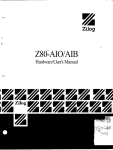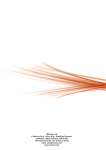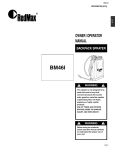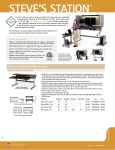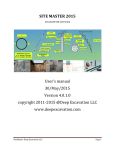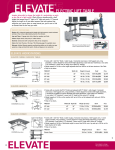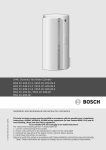Download RM Solar S Class 20 Pro Instruction manual
Transcript
Instruction Manual Issue 4 Note: These Instructions Should Be Read Carefully Before Install, And Before Calling Technical Support. Contents Table Of Contents: Introduction - Page 2 Health & Safety Information - Page 2 Post Installation - Page 2 Section 1 - Product Specifications S Class 10 Specification S Class 20 Specification S Class 20 Pro Specification - Page 3 - Page 3 - Page 4 - Page 5 Section 2 - Positioning & Piping Positioning The Panels Piping Schematics For Panels - Page 6 - Page 6 - Page 7 Section 3 - On Roof Frames Sharks Fin Frame Slate Bolt Frame A Frame Installation - Page 8 - Page 10 - Page 18 - Page 25 Section 4 - In Roof Frames S Class 20 In Roof Installation S Class 10 In Roof Installation - Page 34 - Page 34 - Page 52 Section 5 - Connections & Components - Page 77 System Piping- Page 77 Insulation- Page 77 Glycol- Page 77 Double Pump Station - Page 78 Expansion Vessel- Page 79 Section 6 - Filling The System - Page 80 Filling The System- Page 80 Section 7 - Controller Setup Setting Up The SHE-02 Setting Up The Solastat Setting Up The Resol (East/West Split) Setting Up The Resol (2 Store System) - Page 81 - Page 82 - Page 82 - Page 83 - Page 83 Section 8 - Commissioning & Maintenance Commissioning Certificate Product Guarantees Maintenance - Page 84 - Page 84 - Page 85 - Page 85 Section 9 - Service Log - Page 86 Service Log- Page 86 1 This installation manual contains essential information for the effective and safe installation of RM Solar products. It is essential that this kit is fitted by someone with relevant training or previous experience in the field of Solar Thermal, if this kit is installed without prior training or qualification your guaranteed may be void and your help limited. This technical documentation should be available with you at all times during the installation, but prior to installation please read these instructions as in many cases it will prevent problems from occurring during the installation process. Health & Safety Information RM Solar panels are high quality thermal solar panels using selective coating technology to convert light into heat. RM Solar panels should only be fitted by authorised, trained and qualified personnel. They are not intended to be a “do it yourself” product. Panels are also sometimes called “solar collectors”. Introduction, Health & Safety, & Post Installation Introduction When fitting the panels installers shall comply with all relevant health and safety regulations and shall carry out a suitable and sufficient risk assessment before any work commences. Pre Installation • • Please ensure all equipment is on site, and no parts are damaged. Please make a note of any solar panel serial numbers. Post Installation After the correct and full installation and commissioning of the RM Solar system please make sure you take the following steps: In The Manual Please: • • Complete the product guarantee form included with the solar kit. Complete the product commissioning certificate. Ensure that you: • • • Explain how the system works and how to get the best from the system to the customer. Make sure these instructions are left with the customer. Service the system in accordance with recommended guidance, and complete the log as appropriate. 2 Section 1 - Product Specifications S Class 10 Specification RM Solar’s new S Class 10 panel comes in a variety of arrangements, including standard vertical, oversized vertical, and horizontal panels. Technical Information Collector Casing: Material: Colour: Back Plate: Aluminium Profile Brown AlZn 0.5mm Transparent Cover: Type: Standards: Dimensions: Young Factor: Poisson Factor: Expansion Factor: Light Transmittance: Glass Sealing: Temperated Glass, 4mm prEN 12150, BS6206 Class A 1000 x 2000 / 1200 x 2000 E=70Gpa μ=0.22 0.000009m/mok >89% +/-0.5% Silicone Insulation: Type: Rockwool With Black Fleece Thickness:40mm (back) 20mm (side) Density:40kgr/m3 Thermal Conductivity: 0.044W/mK (100oC) S Class 10 S Class 10 Horizontal S Class 10 Pro Overall Area (m ) 2.09 2.09 2.49 Absorber Area (m2) 1.92 1.92 2.31 2 Aperture Area (m ) 1.92 1.92 2.31 Length (mm) 2030 1030 2030 Width (mm) 1030 2030 1230 Height (mm) 87 87 87 2 Overall Weight (kg) Collectors Installation 49.60 50.50 Horizontal Vertical Absorber Type Grid Grid Grid Absorber Capacity (l) 1.97 1.97 2.23 Selective Selective Selective Coating Thickness (mm) 0.50 0.50 0.50 Absorption 95% +/-2% 95% +/-2% 95% +/-2% Emission 5% +/-2% 5% +/-2% 5% +/-2% Laser Laser Laser Welding Process Stagnation Temperature Certifications Max Working Pressure (Bar) 191 191 193 Keymark Keymark Keymark 10 10 10 Glycol Glycol Glycol S Class 10 S Class 10 Horizontal S Class 10 Pro 78.6 75.9 74.5 a1 (W/m K) 3.62 3.038 3.556 a2 (W/m2k2) 0.028 0.042 0.017 Heat Transfer Medium Type Efficiency (%) 2 3 48.20 Vertical RM Solar S Class 20 solar panel is a vertically mounted glazed collector with collection pipes, intended for applications in systems equipped with circulating pumps. The RM Solar S Class 20 panel is constructed with a single meander system piping without using soldering or welding and is folded into the absorber plate; a single piece tray folded into the frame holding the glazing. The RM Solar S Class 20 panel is not intended to be used in drain-back systems. Section 1 - Product Specifications S Class 20 Specification Technical Information • Floor Space : 2.03 m2 • Dimensions : 1010 x 2010 mm • Weight empty : 36.5 kg • Fluid Volume : 1.3 litres • Recommended flow of heat transfer fluid : 30 L/h/m2 collector • Stagnation temperature : 170°C • Panel connection : in series • Maximum number of panels that can be linked in a series : 3 • Maximum number of series : 1 • Maximum number of panels in parallel: 10 - Please see page 20. • Glazing : 4mm low iron hailstone resistant Tested to EN 12975 (parts 1 & 2) and to Solar Rating & Certification Corporation Standards for the United States of America and to all applicable Canadian test standards Maintenance The panels have been designed to withstand high temperatures; the glass does not require cleaning. There are no user serviceable parts inside and due to the heat exchange process the panel does not contact potable water or water to be heated. Important The panels must be covered for a minimum of 1 hour before filling the system with glycol. 4 Section 1 - Product Specifications S Class 20 Pro Specification The RM Solar S-Class Pro Panel has been specifically designed to meet the needs of large industrial applications. Suitable for both Commercial Buildings, and Private applications, such as large swimming pool installations. The S-Class Pro panels are also available as a horizontal variant allowing installation on roofs where space is a premium. The RM Solar S-Class Pro panel is not intended to be used in drain-back systems. Technical Information • Floor Space : 2.03 m2 • Dimensions : 1010 x 2010 mm • Weight empty : 36.5 kg • Fluid Volume : 1.3 litres • Recommended flow of heat transfer fluid : 30 L/h/m2 collector • Stagnation temperature : 170°C • Panel connection : in parallel • Maximum number of panels that can be linked : 10 • Maximum number of series : Infinite • Glazing : 4mm low iron hailstone resistant Tested to EN 12975 (parts 1 & 2) and to Solar Rating & Certification Corporation Standards for the United States of America and to all applicable Canadian test standards Maintenance The panels have been designed to withstand high temperatures; the glass does not require cleaning. There are no user serviceable parts inside and due to the heat exchange process the panel does not contact potable water or water to be heated. Important The panels must be covered for a minimum of 1 hour before filling the system with glycol. 5 South Facing Roofs Positioning the collectors is important for optimum performance. Collectors should ideally be mounting at an angle of between 30 degrees and 60 degrees on a south facing position that is not shaded by overhanging trees, buildings, or structures. Good results can be obtained by positioning the panels facing anywhere in an arc between south west and south east but due south facing provides optimum performance. North Facing Roofs It is not generally recommended that you install the panels on North facing roofs in the Northern Hemisphere. South of the equator, north will provide the optimum performance and south facing the worst performance. Section 2 - Panel Positioning Positioning the Panels East / West Facing Roofs Good results can be obtained by splitting the collector array on East / West elevations but this should only be used when it is not possible to have a mainly southernly position for the collectors. If you are installing an East / West split system you have to double the number of panels that would normally be required, e.g. a 2 panel system would require 2 panels on the east and 2 panels on the west. East / West Facing Roofs (Alternate Configuration) Another option is to oversize the collector area on the side of the roof chosen to mount the collectors. E.g. If 2 panels would have been adequate had the roof orientation been south, then 3 collectors would be required on either the east side or the west side depending on which recieved the most sunlight. 6 Section 2 - Piping Configurations Piping Schematics For Panels Typical S Class 10 (Parallel) (Maximum 10 Panels Per Bank) Airvent Stop End Sensor Cable Stop End In Out Typical S Class 20 (Series) (Maximum 3 Panels Per Bank) (Maximum 10m Primary Circuit) Sensor Cable In Out Typical S Class 20 (Parallel) (Maximum 10 Panels Per Bank) Sensor Cable In Out Typical S Class Pro (Parallel) (Maximum 10 Panels Per Bank) Sensor Cable In 7 Out The on roof frames from RM Solar come in the following two styles, choosing the correct frame for your installation is paramount to an effective install. Sharks Fin Primarily suited to tile installs. For installation of this frame please see page 10 Section 3 - On Roof Frames On Roof Frames Slate Bolt Primarily suited to slate installs, but will fit most roof types. For installation of this frame please see page 18 Note: It is important to note that the S Class 10 Panel is bigger than the S Class 20 product, so when using on roof products remember to select the correct hole when locating the ‘Z’ rails. 8 Section 3 - On Roof Frames Roof Space Required This is the roof space approximately required to install the panels on roof in millimeters. 8320 9360 9 10400 Before attempting to fit your equipment on the roof please ensure that you have all the equipment required to complete the installation. The table below will tell you what pieces are included in each of the packages. Part Name 1 Panel 1 Panel Extension 2 Panel Frame Connector - 1 Steel Pipe = 2000mm - - 2 2 Steel Pipe = 1000mm 2 2 - - 3 Connection Bolt - - - 2 4 Pipe Bracket 4 4 6 - 5 Shark Tail 4 2 4 - 6 U-Bolt Bracket M8 4 2 4 - 7 Washer M8 8 4 8 - 8 Nut M8 8 4 8 - 9 Adjustment Screw M8 5 2 5 - 10 L-Rail 2 1 2 - 11 Z-Rail Long - 2080mm - - 2 - 12 Z-Rail Short - 1040mm 2 2 - - 13 Frame Connector - - - 2 14 Wind Clamp 2 2 4 - 15 Screw M6 x 16 17 9 17 4 16 Wood Screw 14 8 14 - Section 3 - Sharks Fin Installation On Roof Sharks Fin 10 Section 3 - Sharks Fin Installation 11 1 11 10 17 1 4 14 15 13 15 The instructions show the installation of a 3 panel kit, be sure to only make the connections, and holes in the roof that you require. 11 Section 3 - Sharks Fin Installation Exploded View 3 Panel On Roof Tile Frame (Comprising 2 Panel Frame and 1 Extension) 9 12 8 7 6 10 2 3 12 15 10 5 3 2 12 Section 3 - Sharks Fin Installation Search for the rafters at the position of the collector field. Push up or remove tiles on the total length of the collector field. ca. 104 0m m m 0m 80 17 98 -1 ca.1 040 m m Using the wood screws provided mount the support pipe using the pipe brackets. The distance between the lower batten and pipe centre should be 90mm. If more panels are added use the extension bolts to join the pipes. Extensions must be mounted with 2 pipe brackets [4]. The end brackets should not be more than 500mm from the end of the support pipe. m 90 m 1 2 1 max 500mm 3 1 2 17 4 13 2 9 8 50 0m 7 m Section 3 - Sharks Fin Installation Screw the align screw [9] in the centre hole of the shark bracket. Now use the U-Bolt Bracket [6], washer [7], and nut [8] to fix the hooks to the pipes. Choose so that the brackets are placed under the centre of the panel. Note: The outside Sharks fin should not be more than 500mm from the outer panel edge. Ma x 9 6 Warning: In areas of heavy snow: please replace roof tile with a metal tile, otherwise the roof tile might break under heavy snow loads, or use the slate screw installation kit. 14 Section 3 - Sharks Fin Installation Use screw kit M6 x 16 [15] to connect L-Rails [10] to the Sharks Fin. The end with the most predrilled holes goes to the top of the roof frame. 15 10 5 10 10 15 5 15 A B Section 3 - Sharks Fin Installation Screw the Z-Rail [11] [12] to the L-Rail [10] using two screws M6 and two washers [16] on each connection. Maximum Distance from sharks fin to the end of the Z-Rail must not be more than 500mm! If more than 2 panels are to be mounted use the frame connector as shown in fig. C. Before screws are tightened be sure that a cross measurement has been made. A = B. 15 15 16 16 max. 500 mm 11 12 A 11 B 12 11 12 C 13 15 16 Section 3 - Sharks Fin Installation Place the panels in the correct position. In case of systems with more than two panels, mount the panels starting in the middle. Do not forget to secure the panels together with any straight connectors required (supplied in panel extension set) Mount the wind clamps [14] and connect the panels. Design of the wind clamps may vary - this will not effect the performance of the roof frame. 15 14 14 15 17 Before attempting to fit your equipment on the roof please ensure that you have all the equipment required to complete the installation. The table below will tell you what pieces are included in each of the packages. Part Name 1 Panel 1 Panel Extension 2 Panel Frame Connector 1 Slate Bolt 4 2 4 - 2 L-Rail 2 1 2 - 3 Z-Rail Long - 2080mm - - 2 - 4 Z-Rail Short - 1040mm 2 2 - - 5 Frame Connector - - - 2 6 Wind Clamp 2 2 4 - 7 Screw M6 x 16 13 7 25 - Section 3 - Slate Bolt Installation On Roof Slate Bolt M10 Bolt 2 x M10 Washers M10 Spacer Nut M10 Nut Seal Cap Weather Seal (Sponge) Stainless Bolt 18 Section 3 - Slate Bolt Installation 3 7 8 3 2 6 7 7 5 The instructions show the installation of a 3 panel kit, be sure to only make the connections, and holes in the roof that you require. 19 Section 3 - Slate Bolt Installation Exploded View 3 Panel On Roof Tile Frame (Comprising 2 Panel Frame and 1 Extension) 5 4 1 2 4 20 Section 3 - Slate Bolt Installation Locate the rafters under the slates. Mark the slates where the holes should be drilled so that the hole penetrates the centre of a rafter. Use the angle rail as a template. Note: The distance from the slate bolt to the end of the Z-Rail should not be more than 500mm on each side. ca. 70 -8 00 (*7 00 17 21 ) m m 0 87 -1 104 0m m ca. m m 104 0m m Section 3 - Slate Bolt Installation Drill the holes on each marked position with a high quality 25mm masonry bit. Make sure the drill does not spin too fast or you may break the tile / slate. Do not penetrate beyond the tile / slate. After drilling the holes into the slates, use an 8mm wood bit to make a hole through the rafters at each position. Bolt the bottom part of the slate bolt into each hole. Note: The angle between rafter and drill bit must be 90o. 90° 22 Section 3 - Slate Bolt Installation Use the bolt kit M10 to connect the L-Rails to the self sealing bolt fitting. Note: The L-Rails must be mounted into the long adjustable slot. 2 2 1.3 m 23 to 1.8 Ma x 7 8 Section 3 - Slate Bolt Installation The Z-Rails have to be screwed on to the L-Rails using the M6 screws. Maximum distance from slate bolt to the end of the Z-Rail must not be more than 500mm max. 500 mm 3 4 A 3 7 B 8 4 3 4 5 7 24 Section 3 - A Frame Installation 25 A Frame Installation Before attempting to fit your equipment on the roof please ensure that you have all the equipment required to complete the installation. The table below will tell you what pieces are included in each of the packages. Part Name 1 Panel 2 Panel Frame Connector 1 Panel Horizontsl 1 Rail A 1 2 - 2 2 Rail B 1 2 - 2 3 Rail C 1 2 - 2 4 Z-Rail Long - 2 - 2 5 Z-Rail Short 1 - - - 6 Frame Connector - - 2 - 7 Rail D - 1 - 1 8 Wind Clamp 2 4 4 4 9 Screw M6x16 10 19 - 19 10 Washer 8,4 5 9 - 9 11 Washer 6,4 - 2 - 2 12 Screw M8 x 20 - 2 - - 13 Nut M8 - 2 - - Section 3 - A Frame Installation Exploded View 3 Panel On Roof Tile Frame (Comprising 2 Panel Frame and 1 Extension) 9 8 4 9 10 10 9 13 7 6 4 12 7 6 1 5 3 2 9 5 26 Section 3 - A Frame Installation 27 To protect the panels from getting affected by strong winds they have to be screwed tightly to the rood structure. If this is not possible, each panel must be attached to a minimum weight of 220kg/ panel. This can be done in two ways: 1. Screw the A frame to an aluminium trapeze plate and cover it with gravel. 2. Use concrete blocks as a foundation and screw the A frame to it. 1 2 Section 3 - A Frame Installation Screw the rails 1, 2, and 3 together using 6mm screws (9). The bottom rail has holes for ground or roof fixing. The holes for wall fixing have to be drilled on site. 9 1 2 2 3 9 3 9 1 3 28 Section 3 - A Frame Installation Mount the Z profile, the distance between the last triangle and the end of the Z rail must not be more than 500mm. Pay attention that the triangles are aligned to each other. Use a string to check this, the Z rails must be mounted without any tension. Check cross measurements (A=B). Mount frame connectors if required. 10 9 max 500 mm 5 4 A 4 B 9 5 10 9 29 6 13 Section 3 - A Frame Installation Drill holes 8.5mm on the appropriate place of the back rails. Use the cross rail (D) as a template. Attach cross rail (D), using screws (12), washers (10) and nuts (13), to the back rail of the frame. 10 12 7 13 10 12 7 30 Section 3 - A Frame Installation Mount the panels starting in the middle, mount the wind clamp (8) using screw (9) to the top and bottom of the panel. 4 Wind clamps must be used per horizontal panel. 9 8 8 9 31 8 Section 3 - A Frame Installation Proceed with the next panel. Place extension kit on connection before you place the panel. Make the panel connections. 9 32 Section 3 - Slate Bolt Installation Place the panels in the correct position. In case of systems with more than two panels, mount the panels starting in the middle. Do not forget to secure the panels together with any straight connectors required (supplied in panel extension set) Mount the wind clamps [14] and connect the panels. Design of the wind clamps may vary - this will not effect the performance of the roof frame. 15 14 14 15 33 The In roof frames from RM Solar come in the following two styles, choosing the correct frame for your installation is paramount to an effective install. Minimum roof pitch for installation is 28o Tile In Roof The tile in roof has a shallower profile to accommodate the panels with the thicker roof covering, a flexible corrugated lead flashing is also present to allow moulding to a rolling tile. Section 4 - In Roof Frame Installation In Roof Frames - S Class 20 Slate In Roof The slate in roof has a deeper profile to accommodate the panels with the thinner roof covering. Currently the S Class 20 Panel can only be installed In Roof up to 3 panels, and cannot be installed using the “parallel” method. 34 2540m m 3580m m 4620m m 2550 m m Section 4 - In Roof Frame Installation Preparation The following is the area space required by a set of in roof panels, please ensure you have this area available to you before attempting installation of your equipment. 5660m m 2550 m m 5660m m 2550 m m 6700m m 2550 m m 7740m m 2550 m m 8780m m Note: Additional materials and tools necessary and not included in the equipment supplied: 35 • Minimum of 3 battens in the same size as the ones used in the roof, it can be possible to use battens from the area under where the collector will be mounted. • Wood Screws 4 x 80 to fix the battens to the roof. • Battery drill with 2.5mm HSS drill bit, hammer, measuring tape, wood saw, grinder with stone blade, plumbers tools, ladder, and rope with lashings. 25 20 23 26 23 1 12 Section 4 - In Roof Frame Installation 22 23 3 8 22 2 7 9 10 24 8 4 25 21 23 15 23 10 16 26 23 11 2 8 7 8 9 24 25 5 20 23 10 17 15 23 26 11 23 8 2 8 7 9 6 24 23 8 23 18 10 15 23 8 26 13 25 21 14 22 19 22 20 36 Section 4 - In Roof Frame Installation 37 Important When unpacking the in-roof frame package please check if any pieces are missing using the list below. The pack should contain the following pieces: No. 1 2 3 4/5 6 7/14 8 9 10 11 12/13 15 16 17/18 19 20 21 22 23 24 25 26 Item Angle Bracket Lower Wooden Slat Bottom L/H Flashing Bottom Center Flashing Bottom R/H Flashing Seal Strip 20x20 High Load Support Brackets Wood Wedge Side Seal Strip Center Flashing Side Flashing Wind Protection Rail Top L/H Flashing Top Center Flashing Top R/H Flashing Nail Strips Triangular Seal Sealed Screws (4.5x35) Wood Screws (4x30) Wood Screws (5x110) Sealed Screws (4x80) Wood Block with Hole Single Frame 2 1 1 N/A 1 2.8m 4 1 4m N/A 2 1 1 N/A 1 10 1.8m 4 36 3 2 2 Extension 2 1 N/A 1 N/A 2.2m 2 1 4m 1 N/A 1 N/A 1 N/A 2 1.2m N/A 15 3 2 1 Attach the lower support batten, screw the lower support batten to the rafter along where the collectors are going to be placed. Use screws (4.5x80) Note: These battens and screws are not included. A Section 4 - In Roof Frame Installation Installation Remove the tiles / slates required for installation: 2 Panel Flashing Set = 260 x 260 110cm for every further panel in the same row A = 8,5 - 12 cm 38 Section 4 - In Roof Frame Installation Mount Angle Brackets Mount angle brackets (1) in equal distance with each 4 screws 4x30 (23) to the support batten. With more than 2 collectors, mount first and last angle bracket. Now use a string to level the rest of the brackets by stretching it from one to the other. Now place the lower wooden slat (2) with the cut edge showing upward and screw to angle brackets with each 4 screws 4x30 (23). If the battons are narrow please use 2 battons to mount the brackets. B 1 23 39 B = 0,5 cm 2 2 23 1 4 23 5 Section 4 - In Roof Frame Installation Mounting Lower Flashings Starting from left side, screw lower left flashing (3) at left end to lower slat (2) with screws 4x30 (23). Mount rest of lower flashing (4/5/6) continuing left to right, push flashing together and fit with screw (23) to lower wooden slat (2) where the overlap and on right end. (The flashings must interlock with each other). When finished stick the seal strip at top of flashing edge (7) (covering the screw heads) across total length. 3 4 5 7 6 40 Section 4 - In Roof Frame Installation Mounting Upper Wooden Wedge The upper wooden wedge (no in set incl.) has to be mounted so that the distance between the lower wooden slat and the top angled timber wedge is 1950mm. The top angled timber wedge must sit on at least two battens. Mount a second support batten if necessary. 9 m c 5 9 5 191 m 0m mind. 2 41 Section 4 - In Roof Frame Installation Place and Align Collectors Distance A = 10cm, Distance B = 10cm Place 2 high load support brackets (8) under each collector side. 8 A B 42 Section 4 - In Roof Frame Installation Mounting Top Angled Timber Wedge Place top timber wedge (9) under each collector, align them and secure each with 2 screws 5x110 (24). Connect collector connections as shown in the collector installation manual. Make sure to do a quick A = B measurements on the panels to ensure they are square. NOTE: Pressure test the panels and insert temperature sensor into R/H panel. The panels should be pressure tested to 6.5 bar using either compressed air, or glycol, DO NOT USE WATER. If using glycol cover the panels for the duration of the test. 24 9 A B 43 Section 4 - In Roof Frame Installation Stick Side Seal Strip To Collector Stick side seal strip to the collector sides as shown. You should when applying keep to the external edge of that panel. 10 10 mm 44 Section 4 - In Roof Frame Installation Mount Center Flashings Place center flashing (11) on the lower collector edge and snap in starting from the bottom to the top. Ensure the flashing snaps in tight, if required adjust the gap on the underside of the flashing. Secure flashing into wooden block (26) using screws supplied (25). N.B. Do not over tighten screw (25) this will deform the flashing. 11 25 11 26 45 12 13 Section 4 - In Roof Frame Installation Mount Side Flashings Push the side flashing (12/13) from the side over the collector edge. Use sealing screws (25) to fix the flashings as shown. Be Careful! Do not bend the flashings. The 8” long slit on the side flashings goes at the bottom of the collectors and allows the flashing to flex onto the roof covering. 12 13 25 22 13 46 Section 4 - In Roof Frame Installation 47 Place Top Seal Strip Stick top seal strip (14) across the total length. 14 23 Section 4 - In Roof Frame Installation Wind Protection Rail Place wind protection rail (15) and fix with wood screws 4x30 (23) each 4 times. Note that the buckle must be placed direct over the edge of the wooden wedge (9). Each end of the wind protection rail should overlap the vertical flashings and pin the top of the vertical flashings in place. 15 48 Section 4 - In Roof Frame Installation Top Flashings Starting from the left side. Push top corner flashing (16) under the wind protection rail (15), when located correctly you should no be able to lift the leading edge. Fix with wood screw 5x30 (23) on the right joint and with sealing screw (22) from the left side. Continue with parts (17/18/19). 16 17 Lead ing E dge 23 23 18 22 22 49 NOTE: Seal (21) must be placed at least 10cm down the side flashings (16/19). Additional seal can be ordered from the outlet where the kit was purchased. Section 4 - In Roof Frame Installation Nail Straps Fix top flashings (16/17/18/19) with 2 nail strips and side flashing (12/13) with 4 nail strips (20) each. Stick wedge formed seal (21) across the total length. It must be placed so that after replacing the tiles it will be approximately 5cm under the bottom tile edge. 21 min. 10 cm 20 50 Section 4 - In Roof Frame Installation 51 Place Tiles If necessary, cut tiles to make them fit. Please use the diagram as a guide as to where to tile up to. min. The In roof frames from RM Solar for the S Class 10 Panel only come in one style which is suitable for all roof coverings regardless of whether they are tile or slate. Minimum roof pitch for installation is 28o. This style comes complete with the flexible corrugated lead flashing for molding to a rolling tile. Section 4 - In Roof Frame Installation In Roof Frames - S Class 10 52 2615m m 3700m m 4785m m 2610 m m Section 4 - In Roof Frame Installation Preparation The following is the area space required by a set of in roof panels, please ensure you have this area available to you before attempting installation of your equipment. 5870m m 2610 m m 5870m m 2610 m m 6955m m 2610 m m 8040m m 2610 m m 9125m m Note: Additional materials and tools necessary and not included in the equipment supplied: 53 • Minimum of 3 battens in the same size as the ones used in the roof, it can be possible to use battens from the area under where the collector will be mounted. • Wood Screws 4 x 80 to fix the battens to the roof. • Battery drill with 2.5mm HSS drill bit, hammer, measuring tape, wood saw, grinder with stone blade, plumbers tools, ladder, and rope with lashings. Item Small Wood Screws (4x30) Large Wood Screws (5x110) Sealing Screws (4x80) Small Self Tapping Screws Side Seal Strip Top Square Seal Triangular Seal Bottom L/H Flashing Bottom R/H Flashing Bottom Centre Flashing Colour Coded Bottom L/H Colour Coded Bottom R/H Colour Coded Bottom Centre Middle Flashing L/H Side Flashing R/H Side Flashing Top L/H Flashing Top R/H Flashing Top Centre Flashing Wind Retaining Rail Nail Strips & Nails Top Wooden Wedge Wood Side Section Single Frame 20 10 14 7 4.3m 1.5m 1.8m 1 1 N/A 1 1 N/A N/A 1 1 1 1 N/A 1 10 1 2 Extension 15 7 7 1 4 1.2 1.2 N/A N/A 1 N/A N/A 1 1 N/A N/A N/A N/A 1 1 2 1 1 Section 4 - In Roof Frame Installation Important When unpacking the in-roof frame package please check if any pieces are missing using the list below. The pack should contain the following pieces: 54 Section 4 - In Roof Frame Installation 55 Installation Remove the tiles / slates required for installation: 2 Panel Flashing Set = 270 x 270 110cm for every further panel in the same row Section 4 - In Roof Frame Installation Secure Battens Attach 2 battens using (4.5x80 - not supplied) 450mm and 350mm from the top of the batten beneath. 56 Section 4 - In Roof Frame Installation Mounting The Flashings Starting from the left hand side, place the left hand apron flashing onto the top batton (450mm) and screw into position (just use the top screw holes to secure in place at this point). Note: Please remove the protective plastic coating from the pieces of flashing before it is installed. 57 Section 4 - In Roof Frame Installation Mounting The Flashings Connect the right hand apron flashing to the left hand apron flashing as illustrated (below) ensuring that they interlock correctly. 58 Section 4 - In Roof Frame Installation 59 Mounting The Flashings Note: If the system is larger than 1 panel then the apron from the extension kit is placed between the right hand and left hand flashing of the 1 panel flashing frame. Section 4 - In Roof Frame Installation Mounting The Flashings Slide the colour coded flashings over the galvanized section of the apron, start with the middle sections first (the left hand and right hand corners are always found in the one panel kit box and not on the extension boxes). 60 Section 4 - In Roof Frame Installation 61 Mounting The Flashings These pieces also interlock. Section 4 - In Roof Frame Installation Mounting The Flashings When interlocking correctly the colour coded cover flashing will butt up to the galvanized fixing plates at each end. 62 Section 4 - In Roof Frame Installation Mounting The Flashings Now insert the rest of the fixing screws into the galvanized fixing plates. (approx 100mm from the top). Place the left hand panel into the galvanised fixing plate so it is positioned as shown (below). 63 Section 4 - In Roof Frame Installation Mounting The Flashings Insert the pipe reinforcers (supplied in the install and extension kits) into the panel connections, also put a capnut and olive on to the connection. Now put the neighboring panel (if 2 or more panels) in place, insert pipe reinforcers, capnuts and olives into the panel connections and join the 2 panels together using 2 x 22mm straight connections supplied. The panels at both ends of the collector array should be just lapped by the apron flashing at the bottom when sighted correctly. 64 Section 4 - In Roof Frame Installation Mounting The Flashings At this point measure diagonally across the panels. The two measurements should be the same to ensure the panels are square. A must equal B. A B Mount the wooden latts supplied down the sides (and middle is using 2 or more panels) of the panels using the 3 x large wood screws supplied (5x110mm). The wooden latts should be positioned 200mm from the bottom of the panels and should screw to the battens with a screw at the top middle and bottom. The latts require pilot holes to prevent splitting. The latts are tapered and the 90mm end goes to the top of collector array with the 95mm end going to the bottom. 65 Section 4 - In Roof Frame Installation Mounting The Flashings The panels can now be piped up and the pipework inserted through the roof felt. The panels should now be pressure tested to 6.5bar using either compressed air or glycol. Note: If using glycol cover the panels for at least an hour before and at all times during the test. The picture shown above assumes the panel doesn’t have an in built stat pocket. RM are gradually introducing them across the range. If your panel doesn’t have a stat pocket please attach as photo above. If there is a pocket in the panel please insert the probe into this and secure, the above fitting is then replaced with a T-Piece complete with airvent. 66 Section 4 - In Roof Frame Installation 67 Mounting The Flashings For every panel there will be 1 x wedge shaped wooden section, this needs to be mounted on 2 battens directly above the panel, and secure in place using 2 x (5x110mm) wood screws. Section 4 - In Roof Frame Installation Mounting The Flashings Stick the weather seal (supplied on a roll) to the colour coded apron flashing at both corners and up the vertical edges of the panels. (This foam expands to 10mm deep). 68 Section 4 - In Roof Frame Installation Mounting The Flashings Mount the left hand side flashings starting with the bottom screw, use 1 x small self tapping seal screw (4.5x35mm) at the bottom and 6 x larger sealing screws (4x80mm) up the length, ensure the flashing runs parallel to the panel. Mount the middle vertical flashing (for 2 or more panels) and the right hand side flashings in the same manner. Note: the middle apron flashing will need a 3mm pilot hole drilling on the upstand to enable the small self tapping seal screws (5x35mm) to be fitted. 69 Section 4 - In Roof Frame Installation Mounting The Flashings Stick the square seal along the top of the panels also over the face of the side and middle vertical flashings. 70 Section 4 - In Roof Frame Installation 71 Mounting The Flashings Screw the wind retaining rails into place, the angel should run parallel with the edge of the wooden wedge and should lap over the vertical flashings at either side using small wood screws (4x30). Leading Section 4 - In Roof Frame Installation Mounting The Flashings Starting at the left hand side mount the top flashing ensuring that the leading edge hooks under the wind retaining rail. When located correctly you will not be able to lift the leading edge by hand. Secure in place using 1 x (4x30mm) wood screws (this screw needs to be located as indicated so as not to compromise the water tightness of the flashings. Edge 72 Section 4 - In Roof Frame Installation 73 Mounting The Flashings The top flashings interlock in the same way the apron flashings interlock, continue from left to right. The clips and galvanized nails are used to secure the side flashings and the top flashings to the battens. Section 4 - In Roof Frame Installation Mounting The Flashings Stick the triangular seal along the top of the top flashings and down each side by at least 150mm (if required additional seal is available to order through your merchant from RM Solar). 74 Section 4 - In Roof Frame Installation 75 Mounting The Flashings A small seal screw (4.5x35mm) is used to secure the four corners of the flashings in place, you may need a 3mm HSS drill to pilot these holes. Section 4 - In Roof Frame Installation Mounting The Flashings The roof covering can now be installed at least to the ridge on the side flashings and to the angle on the top flashings. 76 Section 5 - Piping System, Insulation & Glycol System Piping Once you have made the connections in accordance with page 7 be sure to seal and pressure test to at least 1 and a half times the proposed working pressure of the system (suggested working pressure 3 - 4 Bar), normal testing pressure will be 6.5 Bar. Once the system has been tested connections can be taken from the roof space to the proposed location of the double pump station. Be sure to use 22mm Copper Pipe, and Compression fittings. If required using a small amount of sealing compound on the outside of the olive is suggested in order to give a good seal for glycol. Important: Plastic pipe should NEVER be used. Insulation The use of the correct insulation is critical. Normal central heating insulation will melt and become brittle at the very high solar generated temperatures in the system. Insulation materials must endure the highest occurring temperature, which will be more than 170oC near the collector. When the insulation is to be used outside it must be: • Resistant to temperatures up to 170oC • Must have a flexibility in - 30oC conditions • Resistant to air pollution • Resistance to UV radiation • Resistance to pests, such as mice and birds that may eat it • Insulation should be externally sealed to prevent it carrying moisture. RM Solar carry a range of suitable insulation in stock that can be purchashed through your plumbers merchant. Glycol The glycol is used as heat exchange fluid with a very low freezing point, already pre-mixed to allow give a freezing point of -20oC. RM Solar only recommend using the glycol supplied by ourselves and that comes as part of the kit purchased. RM Solar glycol has the following properties: • • • • • • Premixed to give protection down to -20oC (Do not dilute further). Contains anti-corrosion inhibitors for pipe protection Glycol is a low toxic polypropylene product approved for use in solar systems by all major countries including the USA & EU The glycol has a notably more intensive creeping property than water Glycol is not compatible with Zinc, so pipes with internal zinc galvanising should not be used As with all chemicals, normal precautions should be taken in handling the glycol to prevent ingestion and delivery into the water system. Important Under no circumstances should any ethylene based glycol be used in solar systems. The material safety data sheet for the RM Solar glycol is available from RM Solar on request. 77 The double pump station ensures a continuous circulation of the glycol inside the closed solar loop when useful energy is available in the solar panels. The double pump station recommended by RM Solar is constructed so as to be unaffected by the operating temperatures of the loop for many years, however it is always recommended that in order to protect the pump that the cooler glycol returning to the panel passes through the pump. Double Pump Station - Technical Data Maximum working excess pressure: 6 bar Safety valve: 6 bar Circulation pump: Solar Circulating Pump Nominal voltage: AC 230V Power consumption: Speed 1 - 45w Speed 2 - 65w Speed 3 - 90w Maximum pump head: 6m Maximum pump capacity: 6Ltr/Min Temp. Gauge 2 Temp. Gauge 1 Pressure Relief Valve Pump Section 5 - Double Pump Station Double Pump Station Expansion Hose (Do Not Insulate) Pressure Gauge Filling Point 2 Expansion Vessel Connection Vessel Bracket Filling Point 1 Flow Gauge Location Of Double Pump The double pump station must always be mounted at a level that is lower than the panels so that no steam may penetrate the expansion vessel in case of stagnation. Stagnation occurs when the solar panels have heat energy which is not needed by the system and the panels stagnate at around 180oC. If the expansion vessel is mounted at the same level or at a higher level than the panels, an anti-gravity loop must be installed. To install an anti gravity loop the pipe work from the double pump to the expansion vessel should be hard piped in 22mm copper pipe, the pipe should be allowed to fall for approximately 1m from the pump, before rising 1m to enter the expansion vessel. Important 1. Never flush the solar system with water. 2. The double pump station is not suitable for direct contact with swimming pool water. 78 Section 5 - Expansion Vessel Expansion Vessel The expansion vessel protects the solar system during pressure changes and temperature fluctuations. For example, in very hot conditions when energy is not being drawn off, the system may overheat causing the glycol to expand. Technical information (Standard 18L Vessel): Maximum pressure: 10 bar Working pressure: 3.0 - 4.0 bar (20oC) Gas pressure: 2.5 bar Maximum working temperature: 130oC Membrane: Nytril (butyl) rubber Resistance: 40% glycol Sizing It is of critical importance to have the correct size of expansion vessel in your solar system. The volume of the expansion vessel is determined by the number of RM Solar solar panels connected within the one solar heating system. Approximately for one collector 6 litres of expansion vessel volume is required. When fitting a system larger than 3 panels RM Solar should be consulted on expansion vessel sizing. Location The pressure vessel should be located in a position where it can be easily accessed. It should be fitted with isolating valve for ease of replacement. The isolating valve should not be accessible without a tool so that an unqualified person cannot shut it off. The expansion vessel should be fitted on the return run of the system. Where the expansion vessel is sited at the same level as the panels or above, a thermal loop should be present. Maintenance Once an expansion vessel is pressurised correctly it will require yearly maintenance and a visual inspection by a qualified person. Monthly checking of the pressure gauge on a double pump station is also very important, as well as pressure testing the expansion vessel at each maintenance inspection. A pressure drop might indicate: • • • A leak on the pipes connections or A leak on the panels connections or A faulty expansion vessel or loss of pressure in the expansion vessel In the case of any unexpected changes, the customer must contact the installer immediately and the installer should inform the customer of this when explaining the system. Important When installing your expansion vessel ensure that you have not mixed the expansion vessel with another one from somewhere else. The solar expansion vessel has been carefully designed to work with glycol without corrosion. The solar expansion vessel should be clearly marked as being a solar expansion vessel. 79 This guide assumes the use of an RM Solar Filling Pump, no other methods are supported by RM Solar as they can often lead to excess air in the system. Prior To Filling The System Cover the panels 30 minutes before filling the system, and leave covered whilst filling. (If it is not possible to cover the panels, fill the system when there is little solar energy, e.g. early morning, late evening. Ensure the expansion vessel pressure has been set correctly at 2.5 bar. Section 6 - Filling The System Filling The System Connecting The Filling Pump At the Pump Station: 1. Connect the right hand hose (Side with the pressure gauge) of the pumping station to the top filling pump connection of the filling pump. 2. Connect the left hand hose of the filling pump to the bottom filling connection on the solar pumping station. 3. Twist the red and blue temperature gauges on the solar pump station 45o clockwise. 4. Close the grub screw (twist all the way in) on the solar pump station, this is between the pump and the flow gauge. 5. Open the butterfly valves on the pump station where the filling pump hoses are connected, manually open any zone valves ect on the solar primary pipe work. At the Filling Pump: 1. Open the right hand isolation valve, close the left hand isolation valve and open the isolation valve beneath the white tank. 2. Fill the white tank at least half full. Running The Filling Pump 1. Switch on the filling pump - keep the tank topped up to half full. 2. The pressure can be adjusted using the fill pressure regulator on the filling pump. Whilst Filling: 1. Whilst filling open the bleed screw on the solar circulating pump, expel all the air and then reclose. 2. Allow the filling pump to circulate for approximately 1 hour. 3. Check in the filling tank that no air bubbles are returning with the glycol. 4. Close the isolating valve on the solar pump station beneath the circulating pump. 5. Allow the system to pressurise to between 3-4 bar. 6. Close the isolation valve beneath the pressure gauge beneath the pressure gauge on the solar pump station. 7. Switch off the filling pump and close the isolation valves. 8. Remove and drain the hoses from the solar pump station. 80 Section 7 - Controller Setup 81 Control Setup RM Solar provide the original instruction book from the manufacturer for each of the solar controllers supplied, however provided are the recommended wiring details for the controllers most scenarios available. Please check carefully to see which diagrams apply to the controllers being used. The Stelflow hot water cylinder as supplied by RM Solar is designed to work perfectly in conjunction with any RM Solar controller we supply, when using hot water cylinders other than those supplied by RM Solar a pipestat/control stat may be required to enable the solar controller to function correctly. L N E 6 Energy Cut Out 1 C 2 4 1 2 3 4 5 6 7 8 9 10 1 2 3 4 5 6 7 8 9 10 L N E COM T2 AL AL P1 N E 6 2 2 3 L N E 5 3 Br Bl G O Gy 2 Port Valve (Fitted Below Pump) (If not required link 6 & 5 together) SHE-02 Solar Controller Wiring Diagram 3 5 1 6 Energy Cut Out 1 C 4 2 3 4 5 6 7 8 9 10 1 2 3 4 5 6 7 8 9 10 L N E + - + 2 3 4 L N E P Roof Cyl 6 Solar Controller 1 1 2 1 5 2 E Stat L T1 Solar Pump 1 N 3 4 Solar Controller 1 E Section 7 - Controller Setup 3 Stat Solar Pump 1 5 3 3 Br Bl G O Gy 2 Port Valve (Fitted Below Pump) (If not required link 6 & 5 together) Solastat Controller Wiring Diagram 82 L N Energy Cut Out E 1 C 1 2 3 4 5 6 7 8 9 10 1 2 3 4 5 6 7 8 9 10 L N E 4 2 6 4 S1 3 S3 4 5 L 6 1 5 3 9 3 L N E 1 C N E 5 6 7 8 9 10 1 2 3 4 5 6 7 8 9 10 L N E 2 6 3 1 C 2 E 3 1 6 Solar Controller 5 E Energy Cut Out 7 4 S3 4 (If not required link 6 & 7 together) L 4 Tank Sensor 2 3 Tank Sensor 1 Panel Sensor 1 2 3 2 Port Valve (Fitted Below Pump 2) Energy Cut Out 3 12 13 14 15 16 17 18 19 20 1 7 2 Port Valve (Fitted Below Pump 1) 6 2 S2 1 Br Bl G O Gy 3 Port Valve 10 15 3 1 10 S1 2 Br Bl G O Gy 4 3 6 Resol BS Plus - East / West Split Wiring Diagram Solar Pump 1 Tank Sensor 1 2 (If not required link 4 & 5 together) Panel Sensor 2 2 Panel Sensor 1 1 S2 N Solar Controller 12 13 14 15 16 17 18 19 20 E E 1 3 83 2 Stat E 3 Stat Store 1 N 5 Stat Store 2 L 3 Solar Pump 1 Solar Pump 2 Section 7 - Controller Setup 7 2 Store 1 1 7 3 2 Store 2 1 9 3 Br Bl G O Gy Br Bl G O Gy 2 Port Valve (Fitted Below Pump) 2 Port Valve (If not required link 6 & 7 together) Resol BS Plus - 2 Store Priority Wiring Diagram The following steps are important when ensuring the system has been installed correctly and has been setup to run correctly under normal operating circumstances. 1. Ensure the red and blue valves on the solar pumping station are twisted as far anti clockwise as possible (usually inline with the pipework). 2. Open the grub screw beneath the circulating pump fully by turning anti clockwise as far as possible. 3. Set the circulating pump on speed 1, power up the RM Solar Controller and adjust the settings if required. Never run the solar pump dry, doing so will invalidate any pump guarantees. 4. Put the RM Controller into manual operation (ensure any motorised valves ect. on the solar primary pipework have opened). Section 8 - Commissioning & Maintenance Commissioning 5. Set the flow rate between 0.5-1L/m per panel, e.g. a 2 panel system requires a flowrate of between 1-2L/m. 6. To slow the flowrate slowly close the grub screw beneath the solar pump by twisting clockwise. 7. To increase the flowrate switch the circulating pump speed setting up at the pump. 8. When the desired flow rate has been achieved put the controller into automatic mode. The system has now been correctly commissioned. 84 Section 8 - Commissioning & Maintenance Product Guarantee RM Solar Products are guaranteed by RM Solar Ltd as follows: Thermal Solar Panels (Performance) - S Class 20 Only Thermal Solar Panels (Manufacture & Corrosion) - S Class 20 Only Thermal Solar Panels (Manufacture & Corrosion) - S Class 10 Only Pump Station, Controller & Heat Exchanger Other RM Solar Products 20 Years 20 Years 10 Years 1 Years 1 Years In all cases from the day the system was installed & commissioned. The Guarantee is conditional upon: • The solar system is installed by an approved RM Solar installer in accordance with recommended RM Solar techniques & practices, and is serviced in line with our recommendations, and a full service history is recorded. • The installation is paid for in full. • Customer completing the registration form available at the RM Solar website within 28 days of installation. • RM Solar being notified of any circumstance giving rise to a claim hereunder within 28 days of such circumstance arising. The Guarantee DOES NOT cover: • Hot water cylinders and thermal stores, which are separately guaranteed by their own manufacturers. • Workmanship which is separately guaranteed by the installer. All statutory rights are not effected by this guarantee and every subsequent owner of the property at which the thermal solar installation is installed will be recognised hereunder RM Solar Ltd. Maintenance These requirements are recommended by RM Solar Ltd and must be adhered to and must be logged in the service records. Any failure to do so will nullify any manufacturers guarantees, and possibly installer guarantees. In addition these requirements are separate from any regime for the prevention of legionella. The following checks should be carried out at least once every 12 months: • Visual inspection for weeps, leaks, and fluid escapes • Manually operate all valves and pumps to ensure they are working correctly • Visual inspection that system pressure has not dropped into the red zone • Visual inspection that flow gauges indicate correct flow levels • Visual inspection that there is no damage to panels or fixings, this can be done from ground level • If there is pre heating used, regular checks of the heating system for the final heated cylinder should be made • Check the pre-charge of the expansion vessel(s) • Check the whole system for signs of corrosion • Test glycol with approved testing kit • Visual inspection that all insulation is in good condition and not becoming brittle or cracked • If vacuum panels are used, check that the vacuum guage shows that there is still sufficient vacuum, the pointer should be in the green zone. Storage vessels should be checked in accordance with manufacturers recommendations. 85 SERVICE 1 DATE: SERVICE 2 ENGINEER NAME: ENGINEER NAME: COMPANY NAME: COMPANY NAME: TEL NO. TEL NO. COMMENTS: COMMENTS: SIGNATURE: SIGNATURE: SERVICE 3 DATE: SERVICE 4 ENGINEER NAME: ENGINEER NAME: COMPANY NAME: COMPANY NAME: TEL NO. TEL NO. COMMENTS: COMMENTS: SIGNATURE: SIGNATURE: SERVICE 5 DATE: SERVICE 6 ENGINEER NAME: ENGINEER NAME: COMPANY NAME: COMPANY NAME: TEL NO. TEL NO. COMMENTS: COMMENTS: SIGNATURE: SIGNATURE: SERVICE 7 DATE: SERVICE 8 ENGINEER NAME: ENGINEER NAME: COMPANY NAME: COMPANY NAME: TEL NO. TEL NO. COMMENTS: COMMENTS: SIGNATURE: SIGNATURE: SERVICE 9 DATE: SERVICE 10 ENGINEER NAME: ENGINEER NAME: COMPANY NAME: COMPANY NAME: TEL NO. TEL NO. COMMENTS: COMMENTS: SIGNATURE: SIGNATURE: SERVICE 11 DATE: SERVICE 12 ENGINEER NAME: ENGINEER NAME: COMPANY NAME: COMPANY NAME: TEL NO. TEL NO. COMMENTS: COMMENTS: SIGNATURE: SIGNATURE: DATE: Section 9 - Service Record Service Record DATE: DATE: DATE: DATE: DATE: 86
























































































